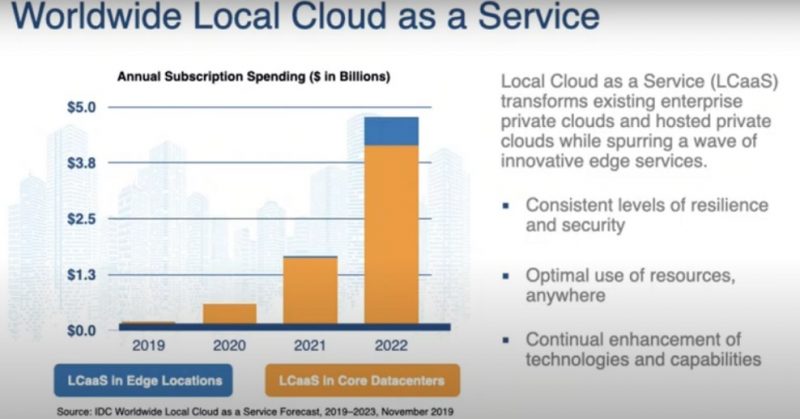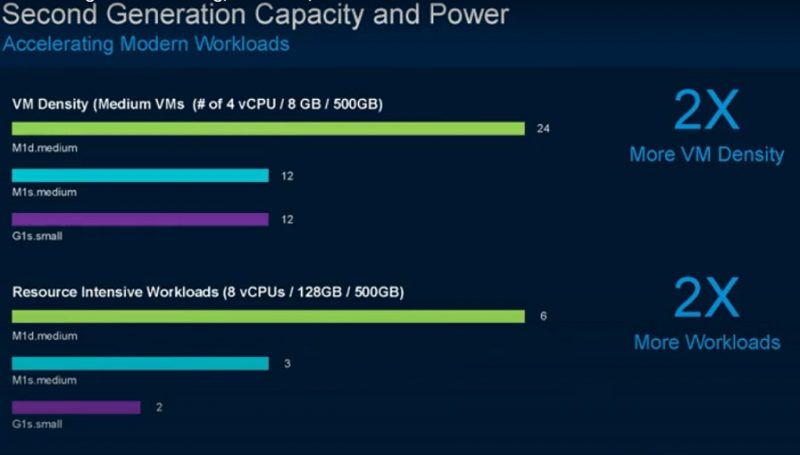 CLOUD
CLOUD
 CLOUD
CLOUD
 CLOUD
CLOUD
On its way through the enterprise forest to the edge, VMware Inc. decided to branch off into the data center.
That’s one conclusion to be drawn from this week’s launch of the second generation of VMware Cloud on Dell EMC. The edge is coming. Yet, for the moment, VMware’s customers are more interested in “cloud anywhere,” especially in the data center.
“While we envision this technology to truly be an edge play, our customers are telling us it’s a data-center play,” said Matt Morgan, vice president of Cloud Platform Business Unit product marketing at VMware. “They believe they can reimagine their data center to operate just like a cloud. By deploying VMware Cloud on Dell EMC, this facilitates their need to do that.”
Morgan spoke with Jeff Frick, co-host of theCUBE, SiliconANGLE Media’s livestreaming studio, during a special VMware Cloud on Dell EMC video series. He was joined by Wei Wang, director of product marketing, CPBU, at VMware. In separate interviews, Frick also spoke with Kit Colbert, vice president and chief technology officer of the Cloud Platform Business Unit at VMware, and co-host Stu Miniman spoke with Rick Villars, vice president of data center and cloud at International Data Corp.
They discussed VMware’s product history, locally based cloud models, customer interest in colocation, how VMware substantially increased capacity and power for the second-generation roll out, and cloud’s future at the edge. (* Disclosure below.)
Watch the complete video interview with Morgan and Wang below:
VMware set the stage for this week’s announcement in 2018 when it introduced Project Dimension at its VMworld gathering. The project capitalized on a cloud-delivered-as-a-service model by extending VMware Cloud to provide software-defined infrastructure. Project Dimension extended this to include on-premises locations.
Fast forward one year later to VMworld in 2019, and the company announced initial availability for VMware Cloud on Dell EMC, positioned as a simple, secure and scalable as-a-service infrastructure for on-premises and edge locations.
“No customer has ever differentiated itself by how well they run VMware infrastructure,” Colbert explained. “Having working VMware infrastructure is just table stakes, and then what they do at an application level is what differentiates them. This idea that we can come in with VMware Cloud on Dell EMC and just take care of all of that operational overhead for them is really powerful.”
There is more to VMware’s strategy than just as-a-service infrastructure. As outlined in a blog post by Colbert at the time of Project Dimension’s introduction two years ago, the company was beginning to zero in on what it saw as an opportunity to address the “compute edge tier” with heavier computation on a local basis.
It’s a trend that research firm International Data Corp. has been tracking, and it reflects the impact of cloud technologies on the data center. Major cloud providers have built bridges, such as Google Anthos, Azure Stack and AWS Outposts, between data centers and their platforms to facilitate an on-prem cloud-like experience. The data center was not disappearing, but it was being gradually transformed.
“We realized we were about to see a new generation of private cloud environments,” Villars said. “But this will be different, not because of new technology, but there will be different use cases and a different approach. It’s not so much a private cloud; it’s a dedicated cloud.”
Watch the complete video interview with Villars below:
What VMware anticipated with Project Dimension in 2018 and what IDC has since validated was the rise of localized compute that consumed resources in an as-a-service method. This gave enterprise customers the agility and responsiveness necessary to process workloads, but more importantly it also would enable cloud infrastructure in new locations, away from the centralized data center.
“I have resources dedicated to a business or service application that I want to get done, and I want to operate that just like those other clouds,” Villars explained. “I want this to be a platform for creating new services that I want to deliver in a location — a factory, a hospital, a city block. We said this is going to lead to the emergence of a whole new product class, which we started to call ‘local cloud as a service.’”
In a report issued last year, IDC found that annual subscription spending for local cloud as a service, or LCaaS, would reach $5 billion in two years. That may not seem like a lot compared to other solutions on the market, but it represents a dramatic rise from less than $1 billion forecast for 2020.

Enterprise interest in colocation, the availability of third-party data centers, plays into this trend as well. Global spending on global colocation services is expected to reach $38 billion in three years as multicloud solutions fuel the need to connect myriad networks.
Colocation solutions also allow enterprises to place data and applications closer to public clouds, thus reducing latency. Last year, VMware expanded its partnership with global colocation provider Equinix Inc. to support VMware Cloud on Dell EMC.
“There are different ways we can expand this,” Wang said. “Many of our customers have expressed interest in colocators. They want us to provide an integrated solution.”
VMware’s second-generation solution represents a turbo boost from the first. It includes double the virtual machine density and twice the amount of capacity for resource intensive workloads.

The message that VMware heard loud and clear from its customers was a desire for more horsepower under the on-premises hood.
“This second-generation solution is all about turning the volume up to 11,” Morgan said. “They needed a new class of systems, something a lot more powerful than our first generation, something that could take on all of the workloads. They wanted to have the opportunity to have a full rack that can beat their expectations on the capacity and power side so they can fulfill their requirements. And that’s what this is all about.”
This is also about the edge. While VMware Cloud on Dell EMC delivers a powerful on-prem cloud model for handling complex, business-critical applications, it is also part of the company’s long game for the edge.
This is precisely where LCaaS, cloud compute managed locally, could become a significant factor in the years ahead.
“We have identified a real need at the edge, so let’s not underplay that,” Morgan said. “A 5G cell tower typically needs compute that’s local, and there’s going to be tons of these erected over the next few years. They don’t have on-premises IT infrastructure people to manage that technology, so there’s an opportunity for an approach where the compute is local, but it’s managed as a cloud.”
The VMware blog post by Colbert in 2018 was prescient in this regard. Sending all the raw data from edge devices back to a central cloud would be slow and costly. Instead, VMware would bring cloud and its operational model to the data.
“Customers want their edge locations to be operational even in the face of network failure or power failure problems, requiring local compute for high availability,” Colbert wrote. “The show must go on!”
Watch the complete video interview with Colbert below. (* Disclosure: VMware Inc. sponsored this segment of theCUBE. Neither VMware nor other sponsors have editorial control over content on theCUBE or SiliconANGLE.)
Support our mission to keep content open and free by engaging with theCUBE community. Join theCUBE’s Alumni Trust Network, where technology leaders connect, share intelligence and create opportunities.
Founded by tech visionaries John Furrier and Dave Vellante, SiliconANGLE Media has built a dynamic ecosystem of industry-leading digital media brands that reach 15+ million elite tech professionals. Our new proprietary theCUBE AI Video Cloud is breaking ground in audience interaction, leveraging theCUBEai.com neural network to help technology companies make data-driven decisions and stay at the forefront of industry conversations.